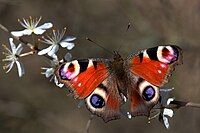
Host plant adaptability and proteomic differences of diverse Rhopalosiphum maidis (Fitch) lineages.
Sign Up to like & getrecommendations! Published in 2021 at "Archives of insect biochemistry and physiology"
DOI: 10.1002/arch.21853
Abstract: Corn leaf aphid Rhopalosiphum maidis (Fitch) can feed on various cereal crops and transmit viruses that may cause serious economic losses. To test the impact of both host plant species and age on R. maidis,… read more here.
Keywords: maidis; maidis fitch; rhopalosiphum maidis; host plant ... See more keywords

A subset of chemosensory genes differs between two populations of a specialized leaf beetle after host plant shift
Sign Up to like & getrecommendations! Published in 2018 at "Ecology and Evolution"
DOI: 10.1002/ece3.4246
Abstract: Abstract Due to its fundamental role in shaping host selection behavior, we have analyzed the chemosensory repertoire of Chrysomela lapponica. This specialized leaf beetle evolved distinct populations which shifted from the ancestral host plant, willow… read more here.
Keywords: clap; plant; host plant; leaf beetle ... See more keywords

Investigating the role of Osiris genes in Drosophila sechellia larval resistance to a host plant toxin
Sign Up to like & getrecommendations! Published in 2019 at "Ecology and Evolution"
DOI: 10.1002/ece3.4885
Abstract: Abstract The underlying genetic basis of adaptive phenotypic changes is generally poorly understood, yet a growing number of case studies are beginning to shed light on important questions about the molecular nature and pleiotropy of… read more here.
Keywords: host plant; resistance; larval resistance; drosophila sechellia ... See more keywords

Even obligate symbioses show signs of ecological contingency: Impacts of symbiosis for an invasive stinkbug are mediated by host plant context
Sign Up to like & getrecommendations! Published in 2019 at "Ecology and Evolution"
DOI: 10.1002/ece3.5454
Abstract: Abstract Many species interactions are dependent on environmental context, yet the benefits of obligate, mutualistic microbial symbioses to their hosts are typically assumed to be universal across environments. We directly tested this assumption, focusing on… read more here.
Keywords: insects; context; host plant; host ... See more keywords

Host plant genetic control of associated fungal and insect species in a Populus hybrid cross
Sign Up to like & getrecommendations! Published in 2020 at "Ecology and Evolution"
DOI: 10.1002/ece3.6266
Abstract: Abstract Plants employ a diverse set of defense mechanisms to mediate interactions with insects and fungi. These relationships can leave lasting impacts on host plant genome structure such as rapid expansion of gene families through… read more here.
Keywords: insects; plant genetic; plant; genetic control ... See more keywords

Alpine butterflies want to fly high: Species and communities shift upwards faster than their host plants.
Sign Up to like & getrecommendations! Published in 2022 at "Ecology"
DOI: 10.1002/ecy.3848
Abstract: Despite sometimes strong codependencies of insect herbivores and plants, the responses of individual taxa to accelerating climate change are typically studied in isolation. For this reason, biotic interactions that potentially limit species in tracking their… read more here.
Keywords: host plant; species communities; change; host plants ... See more keywords

A plant virus enhances odorant-binding protein 5 (OBP5) in the vector whitefly for more actively olfactory orientation to the host plant.
Sign Up to like & getrecommendations! Published in 2022 at "Pest management science"
DOI: 10.1002/ps.7313
Abstract: BACKGROUND The whitefly Bemisia tabaci (Hemiptera: Aleyrodidae) is a notorious agricultural pest and the effective vector of many plant viruses worldwide. Cucurbit chlorotic yellows virus (CCYV), exclusively transmitted by B. tabaci in a semipersistent manner,… read more here.
Keywords: binding protein; host plant; odorant binding; vector ... See more keywords

How does synchrony with host plant affect the performance of an outbreaking insect defoliator?
Sign Up to like & getrecommendations! Published in 2017 at "Oecologia"
DOI: 10.1007/s00442-017-3914-4
Abstract: Phenological mismatch has been proposed as a key mechanism by which climate change can increase the severity of insect outbreaks. Spruce budworm (Choristoneura fumiferana) is a serious defoliator of North American conifers that feeds on… read more here.
Keywords: budworm; host plant; host; phenology ... See more keywords

Nitrogen enrichment in host plants increases the mortality of common Lepidoptera species
Sign Up to like & getrecommendations! Published in 2018 at "Oecologia"
DOI: 10.1007/s00442-018-4266-4
Abstract: The recent decline of Lepidoptera species strongly correlates with the increasing intensification of agriculture in Western and Central Europe. However, the effects of changed host-plant quality through agricultural fertilization on this insect group remain largely… read more here.
Keywords: lepidoptera; fertilization; host plant; lepidoptera species ... See more keywords

Efficient production of polysaccharide by Chaetomium globosum CGMCC 6882 through co-culture with host plant Gynostemma pentaphyllum
Sign Up to like & getrecommendations! Published in 2019 at "Bioprocess and Biosystems Engineering"
DOI: 10.1007/s00449-019-02169-8
Abstract: Endophytic fungus, as a new kind of microbial resources and separated from plants, has attracted increasing attention due to its ability to synthesize the same or similar bioactive secondary metabolites as the host plants. Nevertheless,… read more here.
Keywords: cgmcc 6882; host plant; globosum cgmcc;

Role of Plant Volatiles in Host Plant Recognition by Listronotus maculicollis (Coleoptera: Curculionidae)
Sign Up to like & getrecommendations! Published in 2018 at "Journal of Chemical Ecology"
DOI: 10.1007/s10886-018-0964-y
Abstract: The annual bluegrass weevil (ABW), Listronotus maculicollis Kirby, is an economically important pest of short cut turfgrass. Annual bluegrass, Poa annua L., is the most preferred and suitable host for ABW oviposition, larval survival and… read more here.
Keywords: host plant; agrostis spp; listronotus maculicollis; plant ... See more keywords